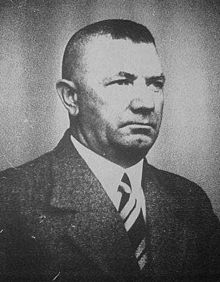Ernst Damzog
Ernst Damzog | |
|---|---|
 Ernst Damzog in civilian clothing, 1935 | |
| Born | 1882 Strasbourg, German Empire (now France) |
| Died | 1945 Halle, Germany |
| Allegiance | |
| Service | |
| Years of service | until 1945 |
| Rank | SS-Brigadeführer |
| Unit | |
Ernst Damzog (Strassburg, 1882 – 1945, Halle) was a Nazi German policeman, Generalmajor, SS-Brigadeführer, member of Gestapo and war criminal responsible for the mass murder of Poles and Jews committed in the territory of occupied Poland during World War II. Damzog joined the SS on 15 June 1933 with the card number 36,157 and became a member of the NSDAP on 1 May 1937 with the number 5,081,001.[1]
Invasion of Poland
In September 1939, during the invasion of Poland, Damzog served as colonel (SS-Standartenführer) of Einsatzgruppe V (EG V-Allenstein) deployed with the 3rd Army (Wehrmacht) in Reichsgau Wartheland (Warthegau) carved out of the Polish lands annexed by Nazi Germany. He was responsible for the mass executions of Polish citizens following the victorious Battle of Grudziądz (Graudenz), practically eradicating the entire Jewish population of the town.[2] He was also in control of the execution of medical patients in order to empty state hospitals,[3] which he entrusted to his subordinate officer Herbert Lange.[4] After the annexation of western Poland, Damzog served in occupied Poznań (Posen) as the police inspector for both Sicherheitspolizei and Sicherheitsdienst (SD),[5] under the command of (SS-Obergruppenführer) Wilhelm Koppe sent to Posen on 30 September 1939.[6]
While in Poznań, Damzog was actively involved in the mass expulsions of Poles from Reichsgau Wartheland to General Government, including after the 1941 German attack across the Soviet zone of occupation. He personally selected staff for the killing centre in Chełmno extermination camp and supervised its daily operation. The first victims there came from the local villages, and the mass killings with the use of gas vans started on 8 December 1941.[7] It was the precursor to the Final Solution, because the idea of systematic genocide by gassing the able-bodied was not yet fully explored. Damzog is said to have related his 'experiments' to both Wilhelm Koppe and Arthur Greiser.[8]
Damzog was stationed in the Gau until 1945, and promoted to the rank of SS-Brigadeführer as well as Generalmajor in 1944 for his swift anti-Polish and anti-Jewish police actions. Damzog was transferred back to Germany ahead of the Soviet offensive. He died in Halle in Saxony during the Allied military campaign of 1945.[5][8]
See also
- Operation Tannenberg extermination action
- Intelligenzaktion targeting Polish elites
- German AB-Aktion in Poland, in spring and summer of 1940
References
- ^ Ernst Damzog Biography. Dws-xip.pl Template:Pl icon
- ^ "Intelligenzaktion na Pomorzu" (Docx direct download 25 KB). 2012. Chomikuj.pl. Retrieved June 26, 2012.
- ^ Henry Friedlander (1997). "The expanded killing program". The Origins of Nazi Genocide: From Euthanasia to the Final Solution. Univ of North Carolina Press. p. 137. Retrieved June 20, 2012.
- ^ Editorial board (2009–2012). "Euthanasia in the Warthegau. Introduction". Tiergartenstrasse 4 Association. Retrieved June 25, 2012.
- ^ a b The expulsions of Poles to General Government. Gostyń. PDF file from Muzeum.gostyn.pl, direct download. Template:Pl icon
- ^ Catherine Epstein (2010). "Ernst Damzog (inspector of Sipo and SD in Posen)". Model Nazi: Arthur Greiser and the Occupation of Western Poland. Oxford University Press. ISBN 0191613843. Retrieved June 21, 2012.
- ^ Catherine Epstein (2010). "Ernst Damzog (ibidem)". Model Nazi: Arthur Greiser and the Occupation of Western Poland. Oxford University Press. ISBN 0191613843. Retrieved June 21, 2012.
- ^ a b Ian Kershaw (January 2011). "Improvised Genocide? The Emergence of the 'Final Solution' in the 'Warthegau'" (PDF file, direct download 1.04 MB). Transactions of the Royal Historical Society, Sixth Series, Vol. 2 (1992), pp. 51-78. Royal Historical Society. pp. 29 (51–78). Retrieved June 25, 2012.
Further reading
- Michael Wildt: Generation des Unbedingten. Das Führungskorps des Reichssicherheitshauptamtes. Hamburger Edition HIS Verlagsgesellschaft mbH, 2002, ISBN 3-930908-75-1
- Shlomo Aronson: Heydrich und die Anfänge des SD und der Gestapo. 1931-1935, S. 217.
- Hansjürgen Koehler: Inside the Gestapo, 1940 S. 36.
